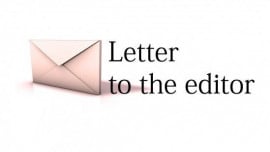
Trying to say what you want to say in a manner that the message is understood as you wish it to be understood, is
far more difficult in a shorter piece than in a longer one. Each time I write, I find myself counting the words, deleting and recounting, again and again.
And, as it happened last week, having squeezed all my wisdom, creativity and craftsmanship into 600 words and emailing the document, I went to bed with the satisfaction of having created what I thought was nearly a Mona Lisa. Early next morning, however, when I was barely out of bed, I get a one-line message from the editor asking me to reduce the article by 60-70 words because of the space problems, and to do it in the next 30 minutes because of the printing deadline. What would you do in a situation like this?
Having been a student and practitioner of business presentations (an opinion piece is not much different in its objectives), I learned that a good presentation has a short, attention-grabbing introduction, a body where you develop your story and a short recap at the end.
But a live stand-up presentation has certain advantages, which are denied to an opinion piece: a captive audience, PowerPoint driven visuals and the opportunity to answer questions to clarify any ambiguities.
Personally, I go through mental contortions before I can bring myself to write something coherent with a clear message. Living in the “suo motu” age does not help either. Nor do the black turbans stimulate much creativity.
A couple of months ago, I sat through a few classes of a writing course before dropping out. (Couldn’t keep pace with the class — too much homework.) But I did scribble some notes in the few classes I attended, which I would like to share with the readers, verbatim from my notebook:
“For a writing to be read, it must be effective and elegant. Effective writing anticipates, shapes and satisfies a reader’s need for information. Elegant writing is more a subjective term, but does not mean flowery and garnished language infested with adverbs, adjectives and ‘intensifiers’. It means clean, logical and efficient writing.
“Sentences that convey more information are more effective than those that convey less. It is called ‘information density. [I would love to measure, if I could, the information density of the lengthy questions and monologues of some of our TV hosts.]
“Sentences in quick, machinegun-like bursts, also called ‘macho language’, may attract attention, but do not carry much information and may become boring after a while.”
There are a few more interesting and useful tips, but the computer tells me I have already used 525 words. Therefore, I cannot go on for too long, but if there was just one tip that I would want to remember, it is this one, by Mark Twain:
“The time to begin writing an article is when you have finished it to your satisfaction. By that time you begin to clearly and logically perceive what it is that you really want to say.”
Published in the Express Tribune, June 6th, 2010.


































































COMMENTS (3)
Comments are moderated and generally will be posted if they are on-topic and not abusive.
For more information, please see our Comments FAQ